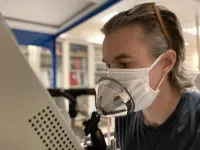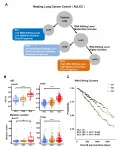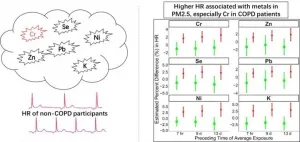(Press-News.org) CHICAGO --- Having trouble falling or staying asleep may leave you feeling tired and frustrated. It also could subtract years from your life expectancy, according to a new study from Northwestern Medicine and the University of Surrey in the United Kingdom (UK).
The effect was even greater for people with diabetes who experienced sleep disturbances, the study found. Study participants with diabetes who experienced frequent sleep disturbances were 87% more likely to die of any cause (car accident, heart attack, etc.) during the 8.9-year study follow-up period compared to people without diabetes or sleep disturbances. They were 12% more likely to die over this period than those who had diabetes but not frequent sleep disturbances.
"If you don't have diabetes, your sleep disturbances are still associated with an increased risk of dying, but it's higher for those with diabetes," said corresponding study author Kristen Knutson, associate professor of neurology (sleep medicine) and preventive medicine (epidemiology) at Northwestern University Feinberg School of Medicine.
But by answering one simple question -- "Do you have trouble falling asleep at night or do you wake up in the middle of the night?" -- people can begin to address sleep disturbances earlier in life and hopefully mitigate this increased risk of death, Knutson said.
"This simple question is a pretty easy one for a clinician to ask. You can even ask yourself," Knutson said. "But it's a very broad question and there are a lot of reasons you might not be sleeping well. So it's important to bring it up with your doctor so they can dive deeper.
"Is it just noise or light or something bigger, like insomnia or sleep apnea? Those are the more vulnerable patients in need of support, therapy and investigation into their disease."
The study will be published June 8 in the Journal of Sleep Research.
"Although we already knew that there is a strong link between poor sleep and poor health, this illustrates the problem starkly," said first study author Malcolm von Schantz, professor of chronobiology from the University of Surrey. "The question asked when the participants enrolled does not necessarily distinguish between insomnia and other sleep disorders, such as sleep apnea. Still, from a practical point of view it doesn't matter. Doctors should take sleep problems as seriously as other risk factors and work with their patients on reducing and mitigating their overall risk."
The authors analyzed existing data of nearly half a million middle-aged participants in the UK Biobank Study. To the scientists' knowledge, it is the first study to examine the effect of the combination of insomnia and diabetes on mortality risk.
"We wanted to see if you have both diabetes and sleep disturbances, are you worse off than just diabetes alone?" Knutson said. "It could have gone either way, but it turns out having both diabetes and sleep disturbances was associated increased mortality, even compared to those with diabetes without sleep disturbances."
Participants had predominately Type 2 diabetes, the most prevalent form, though some had Type 1.
INFORMATION:
Jason Ong, adjunct associate professor of neurology (sleep medicine) at Feinberg is a co-author on the study.
The study was supported by funding from the U.S. National Institutes of Health (grant numbers R01DK095207 and 1R01HL141881) and by a University of Surrey Institute of Advanced Studies Santander fellowship.
In a paper published by the Journal of Sleep Research, researchers reveal how they examined data* from half a million middle-aged UK participants asked if they had trouble falling asleep at night or woke up in the middle of the night.
The report found that people with frequent sleep problems are at a higher risk of dying than those without sleep problems. This grave outcome was more pronounced for people with Type-2 diabetes: during the nine years of the research, the study found that they were 87 per cent more likely to die of any cause than people without diabetes ...
Durham, NC - Critically ill COVID-19 patients treated with non-altered stem cells from umbilical cord connective tissue were more than twice as likely to survive as those who did not have the treatment, according to a study published today in STEM CELLS Translational Medicine.
The clinical trial, carried out at four hospitals in Jakarta, Indonesia, also showed that administering the treatment to COVID-19 patients with an added chronic health condition such as diabetes, hypertension or kidney disease increased their survival more than fourfold.
All 40 patients who took part in the double-blind, controlled, ...
A new study from the University of California, Davis and the Icahn School of Medicine at Mount Sinai confirms that surgical masks effectively reduce outgoing airborne particles from talking or coughing, even after allowing for leakage around the edges of the mask. The results are published June 8 in Scientific Reports.
Wearing masks and other face coverings can reduce the flow of airborne particles that are produced during breathing, talking, coughing or sneezing, protecting others from viruses carried by those particles such as SARS-CoV2 and influenza, said Christopher Cappa, professor ...
Of all the different types of cancer known, a subtype of pancreatic cancer called pancreatic ductal adenocarcinoma (PDAC) is among the most aggressive and deadly. This disease begins in the cells that make up certain small ducts in the pancreas and progresses silently, usually causing no symptoms until advanced tumors actually obstruct these ducts or spread to other places. PDAC is not only difficult to diagnose, but also very unresponsive to available treatments. In particular, researchers have noted that PDAC cells can usually survive radiotherapy through mechanisms that remain largely unknown.
Part of the Radiation and Cancer Biology ...
A new physiological measurement of heart function developed at UVA Health could improve survival for people with heart failure by identifying high-risk patients who require tailored treatments, a new study suggests.
The study is the first to show a survival benefit from wireless pressure monitoring sensors implanted in the pulmonary arteries. Pulmonary artery proportional pulse pressure, or PAPP, is a new measure of heart function, developed at UVA, that can identify patients at very high risk of hospitalization or death from systolic heart failure or pulmonary hypertension (high blood pressure in the heart and ...
Tropical cyclones (TCs) are humbling and powerful forces of nature that can have tremendous impacts on people and human populations. Meteorologists have strived to improve TC forecasting skill, hoping to save lives. In the past few decades, TC track forecasts over the western North Pacific (WNP) have progressed considerably. However, TC intensity forecasts have improved insignificantly, with only a 3-5 day lead time. Therefore, improving TC intensity forecast skill and extending lead forecast time are important and urgent issues.
To address this critical problem, a research group led by Prof. Ruifen ZHAN from the Department of Atmospheric and Ocean Sciences/Institute of Atmospheric Sciences at Fudan University, along with the Shanghai Typhoon Institute of China Meteorological ...
The incidence rate of lung adenocarcinoma (LUAD) is increasing gradually and the mortality is still high. Recent advances in the genomic profile of LUAD have identified a number of driver alterations in specific genes, enabling molecular classification and targeted therapy accordingly. However, only a fraction of LUAD patients with those driver mutations could benefit from targeted therapy, and the remaining large numbers of patients were unclassified. RNA editing events are those nucleotide changes in the RNA. Currently, the role of RNA editing events ...
Glass is one of the most common subjects we see every day, but the detailed structure of this non-metallic and non-liquid material has always been a major mystery in science. A research team co-led by scientists at City University of Hong Kong (CityU) has successfully discovered that the amorphous and crystalline metallic glass have the same structural building blocks. And it is the connectivity between these blocks that distinguishes the crystalline and amorphous states of the material. The findings shed light on the understanding of glass structure.
Glass is a non-crystalline amorphous solid which has widespread practical and technological use in daily life. Besides the soda-lime glass used in windows, there are many other ...
Epidemiological and toxicological studies indicate that the adverse outcomes of PM2.5 exposure associated closely with the chemical composition in PM2.5. Metals in PM2.5 are highly concerned for their induced disruption of iron homeostasis in the lung and following oxidative stress, which is one of the key mechanisms underlying the cardiovascular autonomic dysfunction of PM2.5 exposure. However, there is no clear evidence on whether COPD patients are more susceptible to cardiovascular autonomic dysfunction associated with exposure to metals in ambient PM2.5 than individuals without COPD. Based on a panel study, the researchers directly compared metal-associated cardiovascular autonomic dysfunction between COPD patients and healthy controls.
"We observed higher levels of heart ...
Supermassive black holes (SMBH) occupy the center of galaxies, with masses ranging from one million to 10 billion solar masses. Some SMBHs are in a bright phase called active galactic nuclei (AGN).
AGNs will eventually burn out since there is a maximum mass limit for SMBHs; scientists have long since pondered when that will be.
Tohoku University's Kohei Ichikawa and his research group may have discovered an AGN towards the end of its life span by accident after catching an AGN signal from the Arp 187 galaxy.
Through observing the radio images in the galaxy using two astronomy observatories - the Atacama Large Millimeter/submillimeter Array (ALMA) and the Very Large Array (VLA) - ...








